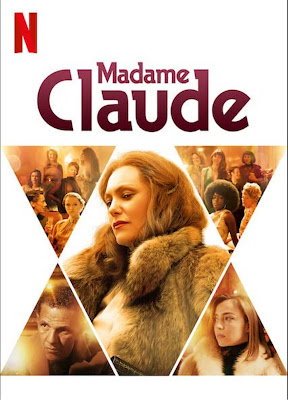 |
| Minx, a show about a magazine that features pictures of penises, ended up being cancelled by dicks—twice. |
If we’re talking about the recent series Minx, the answer is a resounding yes. In this twice-cancelled series, idealistic Vassar grad Joyce Prigger (well-played by the wonderfully named Ophelia Lovibond) thinks readers of the early 1970s would be eager to read her feminist magazine, The Matriarchy Awakens. Unfortunately for her, the publishers she pitches it to aren’t—except one, Doug Renetti (Jake Johnson, also excellent), who runs Bottom Dollar Publishing, producer of skin mags with titles like Lusty Lesbos, Giant Juggs and Feet Feet Feet. He just wants a few changes, in writing style (“When I read it, I feel like a fucking teacher is yelling at me.”) and, most importantly, incorporating photos of naked men. Joyce balks, but her older sister Shelly (Lennon Parham) convinces her to take advantage of the opportunity, reminding her that it’s unrealistic to expect everything she wants. And so, The Matriarchy Awakens gets watered down into a cross between Ms. Magazine Lite and Playgirl: Minx.
Despite having plenty of lube, the Bottom Dollar office/studio is not a well-oiled machine, the operation only loosely supervised by Doug, with his assistant (and sometimes girlfriend) Tina (Idara Victor) frequently stepping in to reign in the chaos. Joyce learns her staff is comprised mostly of Bambi (Jessica Lowe), a nude model now working as “centerfold coordinator” (“I made it up. Doesn’t it sound fancy?”), and Richie (Oscar Montoya), the company’s make-up artist and sole gay male employee, as Minx’s photographer (“[N]one of the other guys want to shoot wieners,” Bambi explains).
Though it’s tempting to dismiss the show as Diane and Sam Make a Porno Mag, Minx has more going for it than that. Joyce struggles to reconcile her feminist ideals (and intellectual snobbery) with the business of selling skin mags, reluctantly accepting she’s becoming the face of sex positive feminism. Doug is cool when controversy makes Minx a best seller, but its high profile also attracts the attention of a Phyllis Schlafly-type city commissioner (Amy Landecker), though what nearly finishes his company is a “Men’s Rights” protest that turns violent. Meanwhile, Richie begins to feel he’s betraying his own community photographing models for the female gaze when Minx owes part of its success to gay readers. And Shelly and her husband Lenny (Rich Sommer) decide to take full advantage of changing mores to spice up their sex life (i.e., they become swingers).
I wanted to watch Minx when it first premiered on HBO Max, but before I could get around to it the show, which had been renewed for a second season, was abruptly cancelled and yanked from the platform. Starz came to the rescue, only to cancel it as well. Then the series landed on Tubi, America’s dumping ground for discarded content. But the series was abandoned way too soon and fully deserved a third season. As it is, viewers will be left wanting to know if Minx will be wrestled away from Constance (Elizabeth Perkins, who became Stockard Channing when we weren’t looking), the wealthy businesswoman who gradually takes over the magazine in season two; if Bambi joins the People’s Temple; and if show runners will ever realize they could audition some ambitious porn stars to do guest spots as Minx centerfolds instead of relying so heavily on prosthetic dicks. Sadly, we’ll never know.
 |
| Spread is better than one might expect, but it’s hardly worth your (or Harvey Keitel’s) time. |
Speaking of taking jobs out of desperation, Spread is run by Frank, played by HARVEY KEITEL! Yes, regularly-cast-by-Martin Scorsese-and-Quentin Tarantino Harvey Keitel. In a Tubi Original. It’s not easy getting old in Hollywood…
In fairness, while Spread is no Taxi Driver or Pulp Fiction, it’s better than one would expect of a Tubi Original. Its production values are at the higher end of mid, and all actors give professional performances if not necessarily likable ones. As one might expect, Keitel gives the most nuanced performance, actually managing to pull at my diseased heartstrings, though the tear he brought to my eye might have more to do with my thinking of how sad it is that Harvey Keitel is accepting roles in Tubi Originals than the plight of his character. Gillies also gets a special shout-out, her performance reminiscent of a Mean Girls era (a.k.a. pre-trainwreck) Lindsay Lohan.
But while Spread is better made than expected, it fails as a comedy. Spread doesn’t set a high bar for itself, so I guess it’s not surprising it mines laughs from raunchy vocabulary words like analingus and from dildos (writer Buffy Charlet and/or director Ellie Kanner find the mere existence of sex toys hilarious). Those jokes are too obvious to pass up. Less forgivable is Spread reducing its characters to caricatures. Ruby describes herself as a feminist, though her commitment to the cause doesn’t go much deeper than putting a “Feminist as Fuck” sticker on her cubicle. What Ruby is, really, is an entitled white girl, appalled that she must take a job she feels is beneath her when she should be working at The Sophisticate, this movie’s fictional stand-in for Vanity Fair.
Yet Ruby is easier to warm up to than other characters, who are either assholes for the sake of being assholes, like editorial assistant Leslie (Bryan Craig), a gel-bombed douchebag who appears to have wandered in from giving nerds wedgies in a different movie, or simply goofy/weird, like Nelson (Blake Harrison), the socially awkward IT guy, and Prudence (Teri Polo), the flighty receptionist. Only David Allan Pearson as Hank, the too-old-for-this-shit editor of the Pussy Quest page, got a genuine laugh out of me.
Minx succeeds by focusing on its characters as they navigate the changing world of the early 1970s. Spread, on the other hand, has little to say, preferring to task its lead with re-organizing the office dildo closet because aren’t dildos funny? Unfortunately for Spread, not nearly enough.











